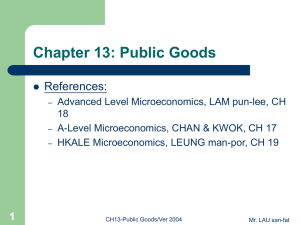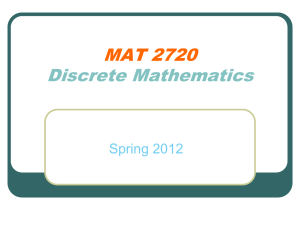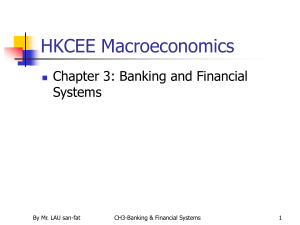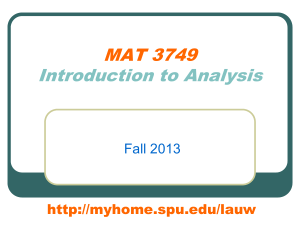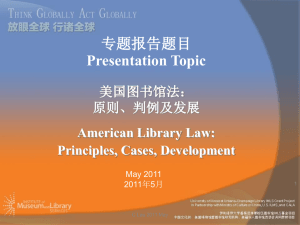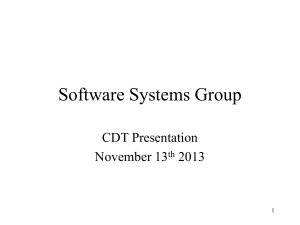Chapter 12: Externality
advertisement
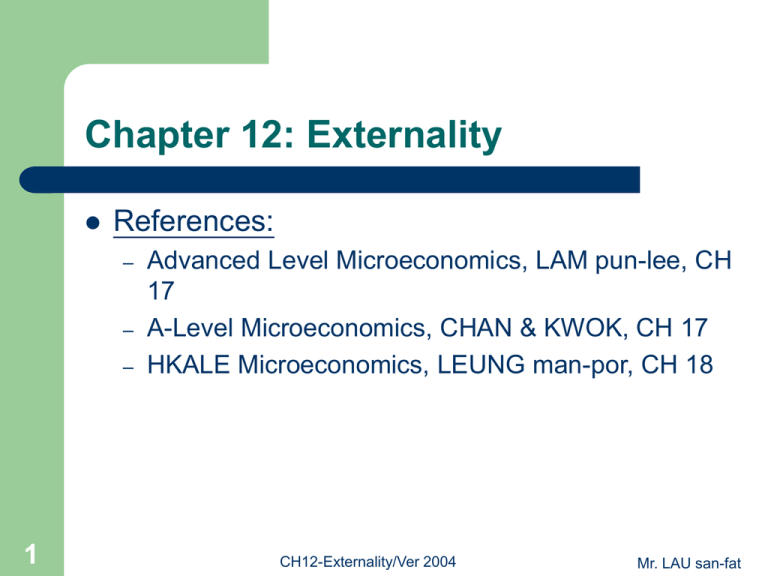
Chapter 12: Externality References: – – – 1 Advanced Level Microeconomics, LAM pun-lee, CH 17 A-Level Microeconomics, CHAN & KWOK, CH 17 HKALE Microeconomics, LEUNG man-por, CH 18 CH12-Externality/Ver 2004 Mr. LAU san-fat Pareto-optimal Condition Pareto-optimal condition is a state where: – – 2 it is no longer possible to reallocate the use of resources so that one individual will gain without loss to another Product P = MUV = MC CH12-Externality/Ver 2004 Mr. LAU san-fat Market Failure If the market is allowed to function without any intervention, market failure means – – 3 the Pareto-optimal condition is not reached non-market institutions would provide a more desirable result CH12-Externality/Ver 2004 Mr. LAU san-fat Externality Externality occurs when the decisionmaker does not bear all of the costs or reap all of the gains from his action As a result, in a competitive market too much or too little of the good will be produced from the point of view of society. 4 CH12-Externality/Ver 2004 Mr. LAU san-fat Externality Positive/Beneifical externality/Social benefit: – 5 If the world around the person making the decision benefits more than he does, then the good will be underconsumed and underproduced by individual decision makers. CH12-Externality/Ver 2004 Mr. LAU san-fat Externality Negative/Harmful externality/Social cost: – 6 if the costs to the world exceed the costs to the individual making the choice (pollution, crime) then the good will be overconsumed and overproduced from society's point of view. CH12-Externality/Ver 2004 Mr. LAU san-fat Private Cost vs. Social Cost Private cost measures the value of the highest-valued alternative uses of the resources available to the decision maker Social cost measures the value of the highest-valued alternative uses of the resources available to the whole society. 7 CH12-Externality/Ver 2004 Mr. LAU san-fat Private Cost vs. Social Cost External/Spillover/Third-party cost or harmful externality occurs when one person's action imposes costs on others without bearing the cost. – 8 Social cost = private cost + external cost The existence of external cost implies that there is a divergence between private and social costs. CH12-Externality/Ver 2004 Mr. LAU san-fat Private Product vs. Social Product Private product measures the value of the product to the decision maker. Social product measures the value of the product to the whole society. 9 CH12-Externality/Ver 2004 Mr. LAU san-fat Private Product vs. Social Product Social product or spillover/thirdparty/external benefit exists when one person's action benefits others without receiving payment. – 10 Beneficial externality = private product + external benefits The existence of external benefit implies that there is divergence between private and social products. CH12-Externality/Ver 2004 Mr. LAU san-fat Harmful Externality 11 With the existence of negative externality, the marginal private cost (MPC) is smaller than the marginal social cost (MSC), resulting in overproduction. CH12-Externality/Ver 2004 Mr. LAU san-fat Harmful Externality P MSC A Remarks: – – MPC1 – B – MUV 0 12 Qe Q1 Assuming MUV=MR Qe = Pareto-optimal output level QeQ1 = overproduced amount AB = divergence between private and social costs Qty CH12-Externality/Ver 2004 Mr. LAU san-fat Harmful Externality P MSC=MPC2 Traditional solution: – MPC1 – MUV 0 13 Qe Q1 Government intervention is required (Pigovian) tax should be imposed to raise the MPC up to the level of MSC and thus eliminating the excess output. Qty CH12-Externality/Ver 2004 Mr. LAU san-fat Beneficial Externality P MC Remarks: – A – B – MSP MPP 0 14 Q1 Qe Qe = Pareto-optimal output level Q1Qe = underproduced amount AB = divergence between private and social products Qty CH12-Externality/Ver 2004 Mr. LAU san-fat Beneficial Externality P MC Traditional solution: – A – B MSP=MPP2 MPP 0 15 Q1 Qe Government intervention is required Subsidy should be granted to raise the MPP up to the level of MSP and thus avoiding the underproduction. Qty CH12-Externality/Ver 2004 Mr. LAU san-fat Pigou's Two Roads B Assumptions: – Road ABD: A D – Road ACD: C 16 – straight but narrow & with limited capacity Traveling time: 1 hr broad & uncrowded but winding & poorly surfaced Traveling time: 2 hrs Average driving time is the only cost of driving from A to D CH12-Externality/Ver 2004 Mr. LAU san-fat Pigou's Two Roads Drivers originally will use Road ABD only If traffic increases to the point of congestion on Road ABD, each road user will slow down the speed of others, thus imposing time cost upon one another 17 CH12-Externality/Ver 2004 Mr. LAU san-fat Pigou's Two Roads 18 Harmful externality occurs since the driver only consider his or her private time cost and ignores the time cost imposed upon all other drivers, there is a divergence between private and social costs. CH12-Externality/Ver 2004 Mr. LAU san-fat Pigou's Two Roads Time(hrs) Road ABD Time(hrs) MC Road ACD AC = MC AC 2 1 0 19 Q1 Q2 Q3 Users 0 Users At Q1, congestion sets in Road ABD, an extra user imposes external time cost on all other users, thus the average time cost will increase CH12-Externality/Ver 2004 Mr. LAU san-fat Pigou's Two Roads Time(hrs) Road ABD Time(hrs) MC Road ACD AC = MC AC 2 1 0 20 Q1 Q2 Q3 Users 0 Users With external costs, a road user considers now only the average time cost instead of marginal time cost Drivers after Q3 would choose Road ACD, resulting in the AC in using both roads is the same, 2 hours. CH12-Externality/Ver 2004 Mr. LAU san-fat Pigou's Two Roads Pigou's argument: – – 21 The Road ABD should be taxed to force some drivers to use Road ACD The diverted users lose nothing as they still spend two hours to travel on the uncongested Road ACD CH12-Externality/Ver 2004 Mr. LAU san-fat Pigou's Two Roads Pigou's argument: – – 22 For those drivers still using Road ABD (except for the marginal user) will still gain as the time saved from being congestionfree is worth more than the amount they are taxed. The market fails to achieve the optimal condition as it is still possible to make someone better off without hurting others. CH12-Externality/Ver 2004 Mr. LAU san-fat Knight's Attack on Pigou Pigou did not specify the nature of property rights governing the use of the roads – 23 No private property rights to roads If the road is privately owned, a toll for its use would be charged, which will be equal to the difference between the values of travel times for the two roads. CH12-Externality/Ver 2004 Mr. LAU san-fat Knight's Attack on Pigou 24 At the margin, the value of travel time for Road ACD and the value of travel time plus the toll for Road ABD will be equal. CH12-Externality/Ver 2004 Mr. LAU san-fat Gordon's Fishery $ = rental value W1 MC MRP 0 Q1 25 Q2 ARP Fishing effort If the fishing ground is privately owned, the equilibrium fishing effort is Q1 and a rental value will be received as the TRP(=ARPxQ1) >TFC(=MCxQ1, given MC = W1. CH12-Externality/Ver 2004 Mr. LAU san-fat Gordon's Fishery $ ARP1 W1 MC MRP 0 Q1 26 Q2 ARP Fishing effort If the fishing ground is commonly owned, an individual fisherman will enter only if the expected average revenue product (say ARP1) is larger than the marginal cost (in terms of the forgone alternative earning in using his or her labor) CH12-Externality/Ver 2004 Mr. LAU san-fat Gordon's Fishery 27 However, the entering of an extra fisherman into the fishing ground will reduce the catch of other fishermen, i.e. they have to bear a spillover cost in fishing. With external cost, there is a divergence between private and social costs, the MRP is thus less than the ARP. CH12-Externality/Ver 2004 Mr. LAU san-fat Gordon's Fishery $ Over-fishing ARP1 W1 MC MRP 0 Q1 28 Q2 ARP Fishing effort A fisherman will enter the fishing ground until the falling ARP equals W1, TRP equals TVC(=MCxQ2), then the rental value becomes zero, i.e. the rent is dissipated. Over-fishing(Q1Q2) occurs. CH12-Externality/Ver 2004 Mr. LAU san-fat Gordon's Fishery 29 With private property rights, the owner of the fishing ground has an incentive to maximize rental value by restricting fishing up to point at where the MRP equals MC. CH12-Externality/Ver 2004 Mr. LAU san-fat Gordon's Fishery 30 Question 1: Why are not all the fishing grounds privatized to eliminate the problem of negative externality in fishing? Must overfishing lead to dissipation of rent? Waste? CH12-Externality/Ver 2004 Mr. LAU san-fat Gordon's Fishery A property may be held in common because the value of capturing its potential rent is lower than the cost of enforcing exclusivity or private property. With prohibitive huge transaction costs, overfishing may be regarded as economically unavoidable and constitutes no wastage. 31 CH12-Externality/Ver 2004 Mr. LAU san-fat Story of Cattle-raiser & Farmer Ronald Coase assumes: – – 32 A farmer and a cattle-raiser share an unfenced property line The raiser's cattle eat or damage the farmer's crops as they stray. CH12-Externality/Ver 2004 Mr. LAU san-fat Story of Cattle-raiser & Farmer Herd size TR ($) 0 1 2 3 4 0 4 8 12 16 33 MR ($) TC ($) 0 1 3 6 10 MC ($) Total gain ($) 0 3 5 6 6 MG ($) Total crop loss($) 2 0 1 3 6 10 MCL ($) MSC ($) 6 Question 2: Fill in the table above. CH12-Externality/Ver 2004 Mr. LAU san-fat Story of Cattle-raiser & Farmer Herd size TR ($) MR ($) TC ($) MC ($) Total gain ($) MG ($) Total crop loss($) MCL ($) MSC ($) 0 1 2 3 4 0 4 8 12 16 0 4 4 4 4 0 1 3 6 10 0 1 2 3 4 0 3 5 6 6 0 3 2 1 0 0 1 3 6 10 0 1 2 3 4 0 2 4 6 8 34 Question 3: What is the size of herd if the cattle-raiser ignores the crop damage? CH12-Externality/Ver 2004 Mr. LAU san-fat Story of Cattle-raiser & Farmer Herd size TR ($) MR ($) TC ($) MC ($) Total gain ($) MG ($) Total crop loss($) MCL ($) MSC ($) 0 1 2 3 4 0 4 8 12 16 0 4 4 4 4 0 1 3 6 10 0 1 2 3 4 0 3 5 6 6 0 3 2 1 0 0 1 3 6 10 0 1 2 3 4 0 2 4 6 8 35 The herd size is determined when MR = MC = $4, i.e. four steers CH12-Externality/Ver 2004 Mr. LAU san-fat Story of Cattle-raiser & Farmer Herd size TR ($) MR ($) TC ($) MC ($) Total gain ($) MG ($) Total crop loss($) MCL ($) MSC ($) 0 1 2 3 4 0 4 8 12 16 0 4 4 4 4 0 1 3 6 10 0 1 2 3 4 0 3 5 6 6 0 3 2 1 0 0 1 3 6 10 0 1 2 3 4 0 2 4 6 8 36 Question 4: What is the size of herd if the cattle-raiser taking the external cost (crop loss) into account? CH12-Externality/Ver 2004 Mr. LAU san-fat Story of Cattle-raiser & Farmer Herd size TR ($) MR ($) TC ($) MC ($) Total gain ($) MG ($) Total crop loss($) MCL ($) MSC ($) 0 1 2 3 4 0 4 8 12 16 0 4 4 4 4 0 1 3 6 10 0 1 2 3 4 0 3 5 6 6 0 3 2 1 0 0 1 3 6 10 0 1 2 3 4 0 2 4 6 8 37 The herd size is determined when MG = MCL = $2, i.e. two steers CH12-Externality/Ver 2004 Mr. LAU san-fat Story of Cattle-raiser & Farmer 38 Question 5: What would possibly be suggested in dealing with the cattleraising phenomenon? CH12-Externality/Ver 2004 Mr. LAU san-fat Story of Cattle-raiser & Farmer With Piguo's analysis: – – – 39 If the cattle-raiser is not liable for the crop damage, there are too many cattle raised but too few the crop grow Resources are misallocated Government should intervene the market by imposing taxes and subsidies, or legal prohibition in order to eliminate the negative externality. CH12-Externality/Ver 2004 Mr. LAU san-fat Story of Cattle-raiser & Farmer Case 1: if the farmer has the right to restrain the cattle-raiser from damaging his or her crops, – – 40 An exchange of the right allows mutual gains The cattle-raiser has to compensate the farmer for buying the right to allow his or her steers to eat crops CH12-Externality/Ver 2004 Mr. LAU san-fat Story of Cattle-raiser & Farmer Herd size TR ($) MR ($) TC ($) MC ($) Total gain ($) MG ($) Total crop loss($) MCL ($) MSC ($) 0 1 2 3 4 0 4 8 12 16 0 4 4 4 4 0 1 3 6 10 0 1 2 3 4 0 3 5 6 6 0 3 2 1 0 0 1 3 6 10 0 1 2 3 4 0 2 4 6 8 41 Question 6: What is then the optimal size of herd? CH12-Externality/Ver 2004 Mr. LAU san-fat Story of Cattle-raiser & Farmer Herd size TR ($) MR ($) TC ($) MC ($) Total gain ($) MG ($) Total crop loss($) MCL ($) MSC ($) 0 1 2 3 4 0 4 8 12 16 0 4 4 4 4 0 1 3 6 10 0 1 2 3 4 0 3 5 6 6 0 3 2 1 0 0 1 3 6 10 0 1 2 3 4 0 2 4 6 8 42 An extra steer should be raised if its expected MG MCL The optimal size is 2 steers as MG=MCL CH12-Externality/Ver 2004 Mr. LAU san-fat Story of Cattle-raiser & Farmer Case 2: if the cattle-raiser has the right to impose damage on the farmer, – – – 43 An exchange of the right allows mutual gains The farmer has to make compensation (equals the forgone MG for not raising a steer) to the cattle-raiser for buying the right to avoid damage by reducing the herd size By doing so, the farmer's marginal gain equals the saved MCL. CH12-Externality/Ver 2004 Mr. LAU san-fat Story of Cattle-raiser & Farmer Herd size TR ($) MR ($) TC ($) MC ($) Total gain ($) MG ($) Total crop loss($) MCL ($) MSC ($) 0 1 2 3 4 0 4 8 12 16 0 4 4 4 4 0 1 3 6 10 0 1 2 3 4 0 3 5 6 6 0 3 2 1 0 0 1 3 6 10 0 1 2 3 4 0 2 4 6 8 44 Question 7: What is then the optimal size of herd? CH12-Externality/Ver 2004 Mr. LAU san-fat Story of Cattle-raiser & Farmer Herd size TR ($) MR ($) TC ($) MC ($) Total gain ($) MG ($) Total crop loss($) MCL ($) MSC ($) 0 1 2 3 4 0 4 8 12 16 0 4 4 4 4 0 1 3 6 10 0 1 2 3 4 0 3 5 6 6 0 3 2 1 0 0 1 3 6 10 0 1 2 3 4 0 2 4 6 8 45 Compensation should continue to be made if the saved MCL MG, The optimal herd size is 2 steers as the saved MCL = MG CH12-Externality/Ver 2004 Mr. LAU san-fat Story of Cattle-raiser & Farmer 46 Question 8: What happen if the farmer and the cattle-raiser jointly own the land for crop-farming and cattle-raising? CH12-Externality/Ver 2004 Mr. LAU san-fat Story of Cattle-raiser & Farmer For joint ownership of a property, the incentive to maximize wealth will guarantee that an efficient allocation of resources. This is simply because the decision of either party will take the external cost into account, i.e. the third party cost now is internalized, eliminating the divergence between private and social costs. 47 CH12-Externality/Ver 2004 Mr. LAU san-fat Story of Cattle-raiser & Farmer 48 Question 9: Suppose that the farmer has the right to restrain the cattle-raiser from damaging his or her crops. The raiser may choose to compensate the farmer or erect fences to prevent his or her steers from straying. Will the cattle-raiser always choose to compensate? CH12-Externality/Ver 2004 Mr. LAU san-fat Story of Cattle-raiser & Farmer 49 The cattle-raiser will choose to compensate if the value of crop loss is smaller than the cost of erecting fences; vice versa. CH12-Externality/Ver 2004 Mr. LAU san-fat The Coase Theorem If property rights are well-defined and transaction costs are zero, then 1. 2. 50 the allocation of resources will be identical, regardless of the initial assignment of property rights; and the allocation of resources will be efficient, so there is no problem of externality CH12-Externality/Ver 2004 Mr. LAU san-fat Coase's Insights 51 With the existence of externality, there are potential gains from exchange. Contractual re-arrangements allow the market participants to capture these gains The initial assignment of property rights will affect only income distribution CH12-Externality/Ver 2004 Mr. LAU san-fat Coase's Insights 52 With positive transaction costs in reality, however, there is still no inefficiency even if the output level exceeds the optimal level because the saved transaction costs are greater than the potential gains from re-arranging contractual arrangement. CH12-Externality/Ver 2004 Mr. LAU san-fat Coase's Insights 53 We should consider both the total and marginal effects of different social arrangements for solving the problem of externality We should not just compare a state of free market to some kind of ideal world (without transaction costs) Externality is reciprocal in nature CH12-Externality/Ver 2004 Mr. LAU san-fat Cheung's Elaboration Two categories of transaction costs: 1. 2. 54 Those incurred in operating an institutional arrangement Those incurred in adopting or changing an institution CH12-Externality/Ver 2004 Mr. LAU san-fat Cheung's Elaboration Two sets of costs restraining institutional change: 1. 2. 55 Those associated with information gathering about alternative institutional arrangements. Those of persuading those members of society whose real income would be reduced by the change. CH12-Externality/Ver 2004 Mr. LAU san-fat The Nature of Externality 56 Externality is universal and pervasive. Externality is reciprocal in nature. Externality arises from inadequate definition of property rights Externality implies the existence of excessive transaction costs CH12-Externality/Ver 2004 Mr. LAU san-fat The Role of Government 57 The basic role of the government is to define clearly the property rights to scarce resources and to protect and uphold firmly the private property rights. Government intervention should be employed to correct externalities only if her cost is less than that of employing other social arrangements. CH12-Externality/Ver 2004 Mr. LAU san-fat Possible Solutions to Externality 1. Government intervention – – – – – 58 Taxation and subsidization Restricting output levels Removing the firm to other location Establishing public ownership Defining or granting property rights and let the market operate CH12-Externality/Ver 2004 Mr. LAU san-fat Possible Solutions to Externality 59 Question 10: What are the possible problems for having government intervention in tackling the problem of externality? CH12-Externality/Ver 2004 Mr. LAU san-fat Possible Solutions to Externality Possible problems with government intervention: – – 60 High costs in identifying the levels of divergences, calculating the associated gains & costs in removing industries, determining the appropriate output level Government is not all-mighty and may herself creates externality CH12-Externality/Ver 2004 Mr. LAU san-fat Possible Solutions to Externality 2. Internalization or self-restraint – 61 With prohibitive transaction costs in making contractual re-arrangement, it is more economically to reduce or eliminate the externality by having self-restraint or internalization (i.e. equalizing MPC with MSC by taking the external costs into account for calculating private marginal cost). CH12-Externality/Ver 2004 Mr. LAU san-fat Possible Solutions to Externality 3. By merging – 62 Merging the parties concerned in an externality by establishing joint ownership has similar effect with internalization on enhancing incentive to reduce or eliminate the third party effect CH12-Externality/Ver 2004 Mr. LAU san-fat Possible Solutions to Externality 4. By doing nothing – 63 No action should be taken if the cost of using any social arrangement to remove or reduce the externality is higher than the potential benefits. CH12-Externality/Ver 2004 Mr. LAU san-fat The Fable of the Bees The apple-grower's orchard provides nectar for the beekeeper. Since the nectar is not marketed, the orchard owner does not receive any payment, resulting in too few trees will be planted. 64 CH12-Externality/Ver 2004 Mr. LAU san-fat The Fable of the Bees On the other hand, the bees in turn pollinate the apple blossoms. Since the pollination service to the applegrower is not paid, resulting in too few hives will be established. 65 CH12-Externality/Ver 2004 Mr. LAU san-fat The Fable of the Bees The reciprocal external benefits illustrate the problem of market failure and thus government intervention is supposed to be the way out. However, Prof Cheung found that the invisible hand functions well for creating active market dealings governing the placement of beehives. 66 CH12-Externality/Ver 2004 Mr. LAU san-fat The Fable of the Bees 67 For plants that require pollination services for fruit setting but yield little or no honey, the orchard-owners pay pollination fees to the beekeepers for the privilege of having hives placed in their orchards. CH12-Externality/Ver 2004 Mr. LAU san-fat The Fable of the Bees For plants that yield honey but require no pollination services, the beekeepers pay apiary rents to the orchardists for the right to place their hives in their orchards. For plants that yield honey and require pollination services, no pollination fees or apiary rents are charged. 68 CH12-Externality/Ver 2004 Mr. LAU san-fat Further Reference Readings 張五常<賣桔者言> 1. 2. 69 如詩如畫的例子 從高斯定律看共產政制 CH12-Externality/Ver 2004 Mr. LAU san-fat
